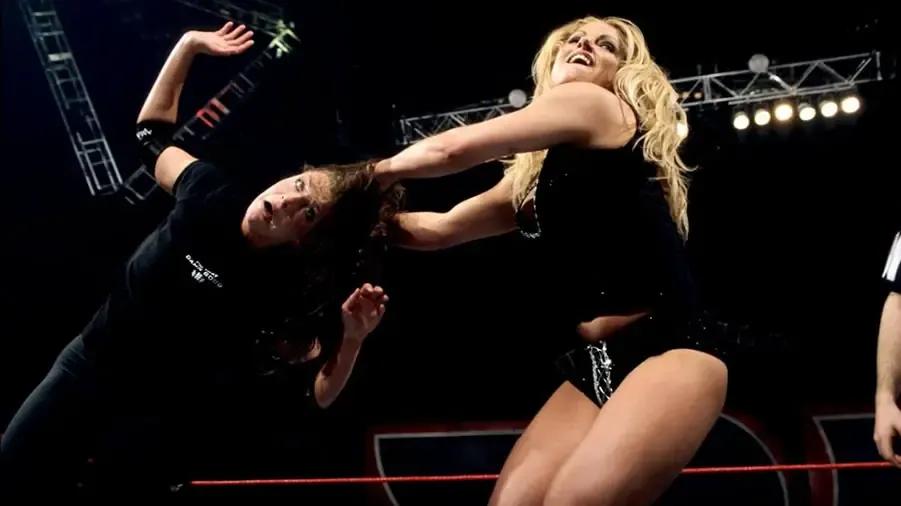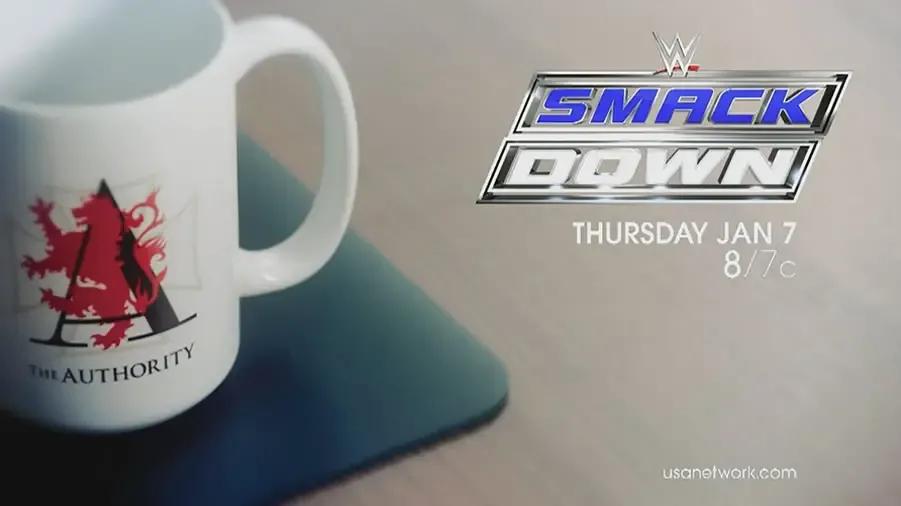10 Things You Didn't Know About WWE SmackDown Live
Ahead of SmackDown 1000, we take a look at some surprising facts and figures…

Oct 16, 2018
If you're well into your adulthood, you've been alive to see SmackDown when its episode numbers were in the single digits, then double, then triple. Tomorrow night will mark the historic step into the quadruples for SmackDown as it celebrates its 1000th episode. You'd have to live about another 173 years in order to live to see SmackDown 10,000, in which head-in-a-jar Roman Reigns successfully defends the WWE Championship against Aurora Levesque's great-grandson. Hope they have WWE Network in the afterlife...
Here at Cultaholic, we like to go digging for some obscure, relatively unknown facts and report them to our loyal joiners, and this list will be no exception. We know SmackDown for many different things: its blue hue, its relegation to the status of B-show in WWE's eyes, its penchant for giving us impromptu tag team matches (depending on which GM was in charge at the time), and the fact that it's *always* better than Raw, always, no exceptions, nope, none whatsoever.
But here, we endeavour to broaden the list of SmackDown-related trivia, revealing some additional facts, and a bit of deeper perspective, about the 19-year-old WWE program that still continues to be a major source of entertainment for many fans across the globe.

When WWE earned clearance for a network-TV broadcast in 1999, to eventually be titled SmackDown, some different ideas were kicked around regarding what the show would feature. Although the show would eventually just become a blue-tinted, post-produced episode of Raw that would here to slightly-stricter Network standards, there was one earlier plan for the show that was a bit different from what we got.
One of the rumoured ideas for SmackDown earlier on was a show that focused exclusively on the women of WWE. Names like Sable, Debra, Chyna, and others proved undeniably popular with the predominantly-male audience, and something that focused on the strength and resolve of the women might've had legs. However, the smaller women's roster, and the dearth of truly-talented in-ring performers, made the idea a little harder to carry out, so WWE instead opted for something closer to Raw.

Although he's the primary voice of WWE today through his lead position on Monday Night Raw, Michael Cole is rather synonymous with SmackDown broadcasts. For most of the show's first decade on the air, he manned the desk, mostly with Jerry Lawler, then Tazz, and later JBL, with his partnership with the former ECW Champion particularly standing out.
A quick check reveals that over these 1000 or so episodes, Cole has had 19 different commentary partners on SmackDown - some for long periods, others for a night or two. The complete list includes Jim Cornette, Jerry Lawler, Michael Hayes, Tazz, Jim Ross, Ernest Miller, Jonathan Coachman, Mick Foley, Todd Grisham, Matt Striker, Josh Mathews, Booker T, Brad Maddox, JBL, Alex Riley, The Miz, Tom Phillips, Byron Saxton, and Corey Graves. That'd make for an interesting battle royal.

When SmackDown initially launched, it was at least expected to be more successful than WCW Thunder, the Thursday night broadcast on TBS that began decently enough only to fall into forgettable oblivion later in 1998. By the time SmackDown came around, Thunder was about as exciting and highly-anticipated as a prostate exam from Captain Hook. And then SmackDown kicked its ass.
With Raw handily thrashing Nitro in the Nielsens by the end of the summer of 1999, SmackDown began to do the same to Thunder on Thursday nights, plunging WCW's numbers down into a laughable range. The beating was so vicious that, in January 2000, less than five months after SmackDown's launch, WCW opted to move Thunder to Wednesday nights, in the hopes of recouping a bit of its audience. Talk about running off the enemy.

The first "weekly episodic" episode of SmackDown premiered on Thursday, 26 August 1999, just days after a hugely-successful SummerSlam pay-per-view in Minneapolis. Raw the night after SummerSlam emanated from Ames, Iowa, the place in which Triple H would become WWE Champion for the first time. For SmackDown's taping on Tuesday night, WWE headed a little further south, to a building that played unfortunate host to recent events.
The venue was The Kemper Arena in Kansas City, MO. Just three months earlier, the arena was the site of Owen Hart's tragic death, as his harness became detached during his entrance. It was the first time that WWE ran the Kemper Arena since Hart's passing, a fact noted by a few fans that brought Owen-related signs to the show. Interestingly, one fan noted in a 2014 post on Live Audio Wrestling that a member of WWE's security detail saw his Owen tribute sign, and advised him only to "show it sparingly".

SmackDown's jumped around the calendar so much that you'd almost figure a DeLorean would have to be involved - going from Thursday to Friday to Thursday to Tuesday to (soon enough) Friday once more, somewhat nomadic throughout its existence (especially compared to Raw, which has remained embedded into Mondays, save for some pre-emptions).
Older fans tend to think of SmackDown as a Thursday venture due to its original placement, but it's actually Fridays that have aired SmackDown the longest. Cumulatively, SmackDown has aired on Thursdays for a total of seven-and-a-half years (six from 1999-2005, a year and a half in 2015-16), while running on Fridays for nine years and four months (September 2005 to January 2015). Since then, it's run for more than two years on Tuesdays, with Fridays fixing to extend that day's overall total a year from now.

Detailing the history of Raw's cable homes in the United States is easy enough: seven-and-a-half years on USA Network, five on TNN/Spike TV, and 13 back on USA. With SmackDown, you need a little bit more of a detailed list to keep track of all of its homes in America over the last 19 years.
In all, SmackDown has (so far) been broadcast by five channels in the US, with a sixth one coming in 2019. Thus far, it's been the defunct UPN Network (1999-2006), the CW Network (2006-2008), MyNetworkTV (2008-10), SyFy (2010-15), and USA (early 2016-present). Incredibly, UPN, a channel that has been dead since September 2006, remains the channel that has aired SmackDown for the longest amount of time stateside. Just talking about UPN's got me in the mood to watch some old Shasta McNasty episodes.

Of all of SmackDown's network jumps, maybe the most regrettable was the move to MyNetworkTV in 2008. Four months after SmackDown premiered on the channel, MyNetworkTV was downgraded from a television network to a second-tier programming service, which hardly made having a presence on
network TV
worth it for SmackDown, which had always lived on non-cable channels since its 1999 launch. Fourteen months after the downgrade, WWE announced that SmackDown would move to SyFy in the fall of 2010.
It should be noted that SmackDown's premiere on MyNetworkTV on 3 October 2008 did the highest rating in MyNetwork history, with 3.2 million viewers tuning in for the premiere. It's a total that hasn't been topped in the decade since. Not even by syndicated episodes of Cheaters.

WWE fancies itself a global entity, and it's justified - when you run pay-per-views in other countries, and have developmental territories set up abroad, you've pretty much carried out global domination to your satisfaction. SmackDown is a worldwide property in its own right, setting down its black-and-blue shoes in three different continents for its weekly broadcasts.
Overall, SmackDown tapings have taken place in seven different countries. The United States and Canada are two of the usual suspects, as well as the bi-annual trips to the United Kingdom. Additionally, SmackDowns have also taken place in Mexico, Italy, Japan (where JBL famously talked trash to an inflatable Godzilla while partially sedated), and Iraq, the latter for a handful of Tribute to the Troops episodes.

From the time Buddy Rogers began sporting it in 1963, the WWE Championship has been considered by many to be wrestling's pre-eminent belt, the focus of so many important rivalries. Title changes on free TV are a little rarer, but the WWE gold has been lost in the ring on 14 different occasions on Monday Night Raw, from Sycho Sid's win over Bret Hart in 1997, to Roman Reigns conquering Sheamus late in 2015.
Over on SmackDown, it's been a different story. Over the last 19 years, the belt has only changed hands three times on the show, beginning with Vince McMahon's unlikely win over Triple H in 1999. That would be followed by Brock Lesnar's victory in the Iron Man match against Kurt Angle in 2003, and then AJ Styles toppling Jinder Mahal in Manchester last year.

The deal was an astronomical one, $205M a year for five years, officially making SmackDown a billion-dollar entity. The FOX Network placed bids for both Raw and SmackDown this past spring, but was only able to wrangle the blue brand away, as USA Network chose not to match their more-than-substantial offer.
According to The Wrestling Observer, it wasn't even FOX that came in with the highest bid for SmackDown. Dave Meltzer would write that one of either Amazon or Facebook had an offer that was "slightly higher" than the FOX offer, but WWE made the FOX deal out of smart business sense. As the SmackDown audience tends to skew older (Meltzer wrote that half of SmackDown's audience is over 53), putting the show on traditional network TV instead of a streaming service more geared toward younger consumers was more logical.